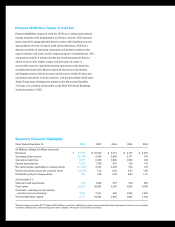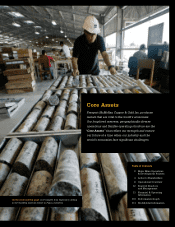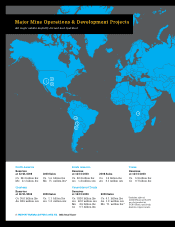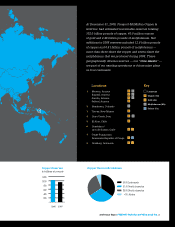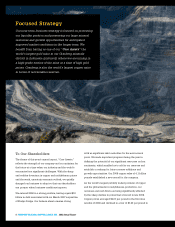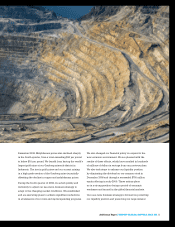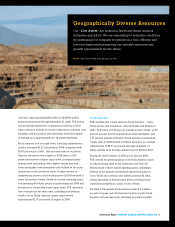Freeport-McMoRan 2008 Annual Report Download - page 12
Download and view the complete annual report
Please find page 12 of the 2008 Freeport-McMoRan annual report below. You can navigate through the pages in the report by either clicking on the pages listed below, or by using the keyword search tool below to find specific information within the annual report.
The mill/concentrating complex
at our Grasberg minerals district
in Indonesia is processing high-
grade ore from the world’s largest
single recoverable copper reserve
and the largest single gold reserve.
PT Freeport Indonesia’s unit net
cash costs are expected to be
significantly lower in 2009 because
of higher gold volumes.
10 FREEPORT-McMoRan COPPER & GOLD INC. 2008 Annual Report
(gold and molybdenum), averaged $1.14 per pound in
2008, and $1.03 per pound in 2007. South America unit
net cash costs were higher in 2008 primarily because of
higher mining costs and milling rates and higher energy,
acid and other commodity-based input costs. These
increases were partly offset by higher production, higher
by-product credits and lower treatment charges.
Assuming achievement of current 2009 sales estimates
and estimates for commodity-based input costs, FCX
expects that average unit net cash costs, including gold
and molybdenum credits, for its South America mines
would approximate $1.00 per pound of copper in 2009.
Indonesia
Through its 90.64 percent owned subsidiary, PT Freeport
Indonesia, FCX operates the world’s largest single
recoverable copper reserve and largest single gold reserve
at its Grasberg minerals district in Papua, Indonesia. Sales
from the Grasberg minerals district totaled 1.1 billion pounds
of copper and 1.2 million ounces of gold in 2008 at an
average realized price of $2.36 per pound for copper and
$861 per ounce of gold. Copper sales for the year were
approximately the same as 2007. Gold sales in 2008 were
significantly lower than the 2.2 million ounces in 2007 because
of a required sequencing of production to mine areas with
lower ore grades. FCX is currently mining in a high-grade
section of the Grasberg mine which is expected to continue
throughout 2009. FCX expects Indonesia sales of 1.3 billion
pounds of copper and 2.1 million ounces of gold for 2009.
PT Freeport Indonesia’s unit net cash costs, including gold
and silver credits, averaged $0.96 per pound in 2008, and
$0.29 per pound in 2007. Unit net cash costs were higher
in 2008, primarily because of lower gold and silver credits
associated with lower gold volumes in 2008 and higher input
costs, including higher mining rates and energy costs. FCX
expects PT Freeport Indonesia’s 2009 unit net cash costs
to be significantly lower than 2008 levels because of higher
gold volumes and reduced commodity-based input costs.
Assuming average gold prices of $800 per ounce for 2009,
achievement of current 2009 sales estimates and revised
estimates for energy, currency exchange rates and other cost
factors, FCX expects PT Freeport Indonesia’s average unit
net cash costs per pound to approximate zero for 2009.
PT Freeport Indonesia has several capital projects in
progress throughout the Grasberg minerals district, including
developing its large-scale underground ore bodies located
beneath and adjacent to the Grasberg open pit. Current
projects include the development of the Grasberg block cave
reserves through the Common Infrastructure adit system;
further expansion of the capacity of the Deep Ore Zone (DOZ)
underground operation to allow a sustained rate of 80,000
metric tons of ore per day with completion targeted by 2010;
and the development of the high-grade Big Gossan mine,
designed to ramp up to full production of 7,000 metric tons
per day by late 2012. FCX is deferring capital spending in the
Grasberg minerals district where practicable.


